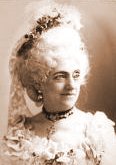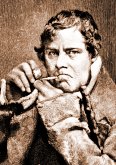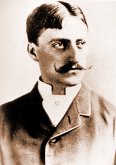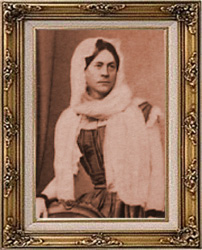
 |
 |
 |
| Louisa Lane Drew | John Drew, Sr. | John Drew, Jr. |
| Louisa & John Drew Sr., married July 1850: | CLICK HERE FOR John Drew Store. | |
Louisa Lane
was born in Lambeth Parish, London, England on January 10, 1820. Louisa wrote "my father, Thomas Frederick Lane, was an actor of considerable provincial fame, and my mother, Eliza Trenter, a very pretty woman and a sweet singer of ballads." Louisa began acting at twelve months old. Louisa was suppose to be a crying baby. This was fine for off stage. But when Louisa was on stage she wrote: "I would not, but at sight of the audience and the lights gave free vent to my delight and crowed aloud with joy." This sounds much like the beginnings of Louisa's great great granddaughter's acting career. When a six-year-old Drew Barrymore auditioned for E.T. Steven Speilberg asked Drew to scream, who wrote that "I was a little better than they expected. They told me that I almost broke the instruments." At the age of five Louisa Lane played Meg Murnock; "The Hag of the Glen." After that Louisa was in Liverpool playing the brother of Frankenstein. Louisa also played a man Prince Agib, confined in prison by Timour, because he was the heir to the throne.
It took four weeks to travel from London to New York. On June 7, 1827 Louisa landed in New York City with her widowed mother to join Cowell/Simpson's company. By September she made her stage debut as Margaretta in "No Song, No Supper," at the Walnut Street Theater in Philadelphia. In September she appeared as a man in"The Duke of York," to the elder Richard III with Junius Booth as Gloster. Junius Booth was the father to the future assassin of President Abraham Lincoln, John Wilkes Booth.
On January 5, 1829 The following was published on Louisa Lane and her performance: "Miss Lane.--This astonishing little creature appeared at the Chestnut Street Theatre last evening. She is not more than ten years of age, and evinces a talent for and a knowledge of the stage beyond what we find in many experienced performers of merit. The entertainment of "Twelve Precisely" is well adapted to the display of the versatility of her powers; and in the Irish Girl she man, with truth, be pronounced inimitably comic. Her brogue and manner are excellent. The Young Soldier was also admirably assumed; his coxcombical airs were natural, evinced astonishing observation in a child so young, and literally convulsed the house with laughter. Her performance of Little Pickle also possessed great merit, and the applause bestowed upon her throughout the evening bespoke the wonder and delight of the audience. Those who have a taste for the wonderful should not miss the present opportunity of gratifying it. We promise ourselves a treat of no ordinary kind when she appears as Goldfinch in the Road to Ruin." Extract from Philadelphia newspaper.
Mrs. Thomas Lane, Louisa's mom, remarried John Kinlock a stage manager, actor and manager. In 1830, Louisa's stepfather was "bitten with the idea of management, arranged a partnership with Mr. Jones, in New York to take the company out to Jamaica, West Indies. While in Kingston, Jamaica, Louisa wrote "yellow fever killed her father, his youngest child and nearly took my mother."
In March of 1828 she made her New York debute in The Spoiled Child at the Bowery Theater. For the next six years Louisa Lane was known as a "child actress" and was very popular. Louisa acted in New York at the Browery Theater where she first appeared on March 28, 1828 in her performance in Little Pickle and At the Park. She also was seen in Baltimore, Boston and Philadelphia. Her repertory included a sketch entitled "Twelve Precisely; or, A Night at Dover," in which she impersonated five characters; "The Heir at Law," in which she toddled about as Pangloss; "The Road to Ruin," in which she was an infantile Goldfinch; "The Four Mowbrays," and "The Actress of All Work."
In 1832 Louisa went to Washington to visit with one Mrs. Eaton who took her to meet President Andrew Jackson. Louisa wrote: "He was very kind and sweet to me, kissed me, and said I was 'a very pretty little girl.' Need I say that I was a Jackson Democrat from that hour, and have remained one..." Louisa may not of heard of Jackson's reputation as a duelist. On one occasion Thomas Hart Benton and Jackson almost killed each other.
The mystery about Louisa's age was well preserved; and wherever she went she excited a deal of curiosity, if her performances were productive or no better result. She married in 1838 to Henry Hunt, a young Irish actor a native of Dublin. In 1838 she was employed as an actress by the Walnut Street Theater a position she held on to for till 1850. She married twice before she married John Drew in July of 1850. For 11 years John and Louisa Drew toured together and separately. Louisa Lane wrote:
"...in 1850 I was married to Mr. John Drew, although the marriage was not made public for some months, as I had several engagements to fulfil before I could join him. Then we went to Chicago for the season, and Buffalo, then to Albany...went in the summer to New York, to act small comedies at Niblo's..." Afterwards Louisa went to the Chestnut Street Theater in Philadelphia to act with her husband in "She Would and She Would Not."
In 1853 John Drew became the lessee of the Arch Street Theater in Philadelphia. In 1861 Louisa (Lane) Drew was approached by the owner to assume the management, which she did. It reopened as Mrs. John Drew's Arch Theater and kept its doors open until 1892. Louisa often acted in male roles (highly unusual in that day and age) such as Romeo, Mark Antony and other Shakespearean roles; a family tradition which was carried on by her grandson John Barrymore, second great grandson John Blyth Barrymore, III and second great granddaughter Drew Barrymore. While married to John Drew, Sr. she had three children within five years Louisa, John and Georgia."
In the book "The Life of John Barrymore," by John Kobler he wrote of Louisa's theater: "The nucleus of Mrs. Drew's Stock Company...engaged celebrated outsiders...such as Edwin Forest, Edwin Booth, Fanny Davenport, Charlotte Cushman, Joseph Jefferson, to name a few...A performance of Macbeth starring John Wilkes Booth took place on March 13, 1863, two years before he assassinated Lincoln. Louisa treasured a letter that Lincoln wrote to her, dated June 25, 1864:
Madam, Please accept my thanks for the invitation given me to attend the Arch Street Theatre during my recent visit to Philadelphia--I also beg your pardon for having long delayed the acknowledgment. Yours tr. A. Lincoln."
Louisa Drew always said that she was an Andrew Jackson Democrat. Yet there was no conspiracy when she played Lady Macbeth with J. Wilkes Booth on March 13, 1863 at Mrs. John Drew's Arch Street Theatre. This was a Fairwell Benefit of John Wilkes Booth, and his last appearance but one. Tonight, Friday, March 13, 1863. Almost one century before Lee Harvey Oswald was to take the blame for Kennedy's demise. The cast was :
Macbeth.......John Wilkes Booth ****
Maduff.........Barton Hill
Banquo.........Mr. Albaugh
Malcolm.......Mr. Ringgold
Lady Macbeth.....Mrs. John Drew ****
Hecate...........Mrs. C. Henri
First Witch.....Mr. A. Bradley
Second Witch....Frank Drew (uncle to John Drew Jr.) ****
Photograph to the right is Frank Drew dressed in drag, collection Wm. Seymour.
CLICK HERE FOR Louisa Lane - aka. Mrs. John Drew Portrait Gallery.
John Drew Jr. wrote upon the passing of his mom: " The following retrospect of a life well spent in the pursuit of the most exacting of professions was written down for the immediate delectation and edification of the children and grandchildren of the gifted woman who penned it. I think, however, that when such an example may teach so much; where the life of an actress has been so full of incident and accident, and all resulting--through force of character and absolute intrinsic worth--in ultimate personal and professional regard and reverence, I think that the record of such a life, reaching over seventy years of dramatic history of our country, cannot be without interest to all who have at heart the development of art at its best...John Drew, Jr.."
In 1880 or 1881, Louisa joined with Joseph Jefferson to act as Mrs. Malaprop in "The Rivals." Louisa wrote: "I forget how many miles...we traveled that season...but I know [somethink like] 19,000 and some." Louisa's son John Drew introduced Maurice Barymore to his sister which was the beginning of the Barrymore legend within the United States. Their first cast of the comedy was as follows in part:
(Sir Anthony....Fred Robinson); -(Captain Absolute....Mr. Maurice Barrymore) - (Fag...Joe. Jefferson)
(Mrs. Malaprop....Mrs. John Drew) -- (Bob Acres...Mr. Joseph Jefferson - Photo of below)

In 1893 Louisa wrote "The keenest sorrow of my life came to me in '93, when my dearest daughter, Georgie, died in California, where she had gone in search of health, and only found death. My eldest daughter died some five years ago and now my son John [Drew] is the only remaining link with his father's memory. I look on him with considerable pride..."
Louisa (Lane) Drew's "Autobiographical Sketch of Mrs. John Drew" was published in 1899 two years after her death August 31, 1897. At the time of her death The New York Times wrote that : "Mrs. John Drew probably had a longer career than any other actress. She was a remarkably versatile and intelligent actress, and although her efforts late in life were exclusively confined to comedy, yet she won respect in tragedy as well, and had, in fact, acted all sorts of characters from Little Pickle to Jane Shore, from one of the smothered Princes in "Richard III." to Rosalind and Ophelia. Louisa Lane made her first appearance on the stage in Liverpool at the age of eight years old in a play called "Timour the Tarter."
John Drew, Sr.
Born in 1827 John was the son of the treasurer of Niblo's Theatre in New York. John Drew, Sr. was twenty-three years old at the time of his marriage to Louisa Lane and had been on stage five years. He, was an Irishman, and was born in Dublin. The experience of his wife was of great value to him in shaping his career. He soon became noted, and in certain comedy characters, calling for lightness and elegance as well as broad humor in their treatment, he has never been equaled on our stage." Mr. and Mrs. Drew went to Philadelphia in 1852. John Drew made his first appearance in Philadelphia August 28, 1852, as Trapanti, the lying valet, in "She Would and She Wouldn't," Mrs. Drew being Donna Hypolita. The next year Mr. Drew, in partnership with William Wheatley, assumed the management of the Arch Street Theatre, from which he retired two years later to make a professional visit to England and Ireland, Mrs. Drew remaining in Philadelphia. When he returned in the Spring of 1857 Mr. Drew leased the old National Theatre and opened it with "The Naiad Queen." Joseph Jefferson, Edwin Adams, George Boniface, and Mary Devlin, afterward the wife of Edwin Booth, were members of the company, but the house was closed within three months. In November, 1858, Mr. Drew started a tour to California and Australia, and during his absence (1861) Mrs. Drew assumed the management of the Arch Street Theatre. Mr. Drew died in the Spring of 1862 in an accident after he fell down a the stairs.CLICK HERE FOR John Drew and Joseph Jefferson Portrait Gallery.
More click on link to read about John Drew Jr. go here.